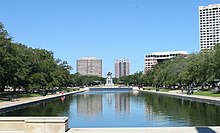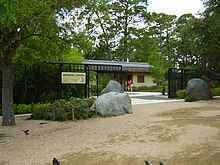|
Hermann Park
Map of Hermann Park    Hermann Park is a 445-acre (180-hectare) urban park in Houston, Texas, situated at the southern end of the Museum District. The park is located to the immediate north end of the MD Anderson Cancer Center at Texas Medical Center and Brays Bayou, east of Rice University, and slightly west of the Third Ward. Hermann Park is home to numerous cultural institutions including the Houston Zoo, Miller Outdoor Theatre, the Houston Museum of Natural Science, and the Hermann Park Golf Course, which became one of the first desegregated public golf courses in the United States in 1954. The park also features the Mary Gibbs and Jesse H. Jones Reflection Pool, numerous gardens, picnic areas, and McGovern Lake, an 8-acre (32,000 m2) recreational lake.[2] The opening of the Houston Zoo in 1922[3] and the requisition of a large southern portion of the park for the establishment of the Texas Medical Center in 1943[3] fundamentally altered the scope and configuration of the space, though significant elements of the Kessler plan—such as the north-south axis extending from Montrose Boulevard—remain and have been expanded upon.[4] Hermann Park experienced a period of neglect in the latter half of the 20th century due to a lack of funding and maintenance, spurring the formation of the nonprofit Hermann Park Conservancy in 1992. The Conservancy has since leveraged over $120 million of public and private funds to renovate and remake broad areas of the park.[1] Today, Hermann Park welcomes over six million visitors annually;[1] the Houston Zoo was the second most visited paid-admission zoo in the United States in 2016 (behind San Diego Zoo), with over 2.5 million visitors.[5] Hermann Park is served by the Hermann Park / Rice University station on the METRORail Red Line, which runs along Fannin Street at the western edge of the park. The Third Ward Redevelopment Council defines Hermann Park as being part of the Third Ward. T. R. Witcher of the Houston Press wrote in 1995 that the park and nearby areas are "not the first places that come to mind when you say "Third Ward,"[...]".[6] HistoryInitial land acquisitionOne of Houston's oldest public parks, Hermann Park was created on acreage donated to the City of Houston by cattleman, oilman and philanthropist George H. Hermann (1843–1914). The land was formerly the site of his sawmill.[7] It was first envisioned as part of a comprehensive urban planning effort by the city of Houston in the early 1910s.[4] Following the recommendation of a 1913 report which identified the then-rural area between Main Street and Brays Bayou as ideal for a large urban park, real estate investor and entrepreneur George H. Hermann, who owned most of the area and served on the city's parks board, bequeathed his estate to Houston for use as a public green space in 1914.[4][8] The Kessler PlanIn 1914, Joseph Stephen Cullinan proposed to the Houston park commissioners and Mayor Ben Campbell to hire George E. Kessler to plan Hermann Park. Kessler was already developing public plans for the cities of Dallas and Fort Worth, and the city opted to contract with Kessler, despite the previous work by John Maxcy and Arthur Comey. Two years later, Cullinan purchased a 38-acre wedge of land from the Hermann Estate for his planned gated enclave, Shadyside. He commissioned Kessler to lay out the subdivision. Cullinan chose the site for Shadyside knowing that it would be adjacent to the large swath of land dedicated to the development of public amenities, including Hermann Park. Not only would Kessler ensure that similar aesthetic choices would be implemented at Shadyside and Hermann Park, this coordination prevented commercial development from encroaching on the common sides of the properties.[9] As with the neighboring development of Shadyside, Kessler devised his plan for Hermann Park with knowledge of other adjacent land tracts dedicated to public use. The Rice University, opened in 1912, lay to the west of the Hermann Park tract. The 295-acre campus was then implementing its own master architectural and landscaping plan developed by Cram Goodhue & Ferguson. To the northwest, adjacent to Shady Acres, was entrusted by George Hermann in 1913 to the Houston Art League, which started planning for an art museum there after 1917.[10] By 1916, famed landscape architect George Kessler had completed a master plan for the park which was gradually implemented throughout the following decades.[4] Ultimately, Hermann Park and Rice University are two clear expressions of the City Beautiful movement in Houston. Hare & Hare Plan
Mid-century development
The Olin PlanIn 1993, FHP commissioned a master plan for Hermann Park from Hanna/Olin Partnership of Philadelphia. This Master Plan, created in consultation with the City of Houston and various stakeholders, was adopted in 1997 by Houston City Council. In 1995, Friends of Hermann Park adopted a master plan for Hermann Park that has provided a “blueprint” for all subsequent renovations and enhancements to the Park. In 2004, Friends of Hermann Park changed its name to the Hermann Park Conservancy (HPC) to reflect an institutional and permanent commitment to stewardship of Hermann Park’s natural resources and physical infrastructure. In an international competition, the Rice Design Alliance invited designers to set the tone and revitalize the main entry and reflecting pool that formed a key axis for Hermann Park, “The Heart of the Park”, and to create a contemporary update to the park's earliest plans by George Kessler and a subsequent, more formal Hare & Hare plan in 1936. SWA Group, an international landscape and urban design firm working in conjunction with W.O. Neuhaus Architects and other consultants, was selected over 100 respondents. The most striking of the changes to the 18-acre (7.3 ha) project area was a narrower, more inviting 80-foot-wide (24 m) by 740-foot-long (230 m) reflection pool. It establishes the formal central axis for the space and its slight narrower design afforded elegant pedestrian promenades as well as a double-row of mature Live Oak trees – one row that had been planted in the 1920s to honor veterans of WW I, and a second row that was added as part of the project. The Hermann Park ConservancyHermann Park was presented to the City of Houston by George Hermann in 1914, and is now Houston's most historically significant public green space. Over the years, the Houston Zoo, Miller Outdoor Theatre, the Houston Museum of Natural Science, and one of the first desegregated public golf courses in the United States all have added to the Park's importance as a recreational destination. By the late 1980s however, due to insufficient public resources and very high public attendance, the park became rundown and entered a state of disrepair. In response, a group of committed and visionary Houstonians formed the nonprofit organization known as the Friends of Hermann Park (FHP) to encourage the development of more attractive, usable green space in Hermann Park and to promote the restoration of the Park to its originally intended standards of beauty. Noted in a winning entry for the 2005 National Award of Excellence from the American Society of Landscape Architects, the “Heart of the Park” reflecting pool utilized a biofiltration system of gravel beds and perforated pipes to trap organics so that they naturally decompose. Porous paving systems and decomposed granite also limit potential damage from increased water run-off from the site. Ongoing projects  The Hermann Park Conservancy continues working in partnership with the City of Houston to secure funds and manage the design of projects to be undertaken in the Park:
The Conservancy also developed a Maintenance and Operations Master Plan Study for Hermann Park - the first such comprehensive study ever for this flagship park of Houston. The study identified many concerns for preserving and protecting Hermann Park, including a gap of 20,000 maintenance hours for the Park. In response, the Conservancy hired a Manager of Volunteer Programs. In 2004 over 1,200 volunteers provided over 14,000 hours of volunteer service in the park. Attractions   
References
Bibliography
Further reading
External linksWikimedia Commons has media related to Hermann Park, Houston.
|
||||||||||||||||||||||||||||||



